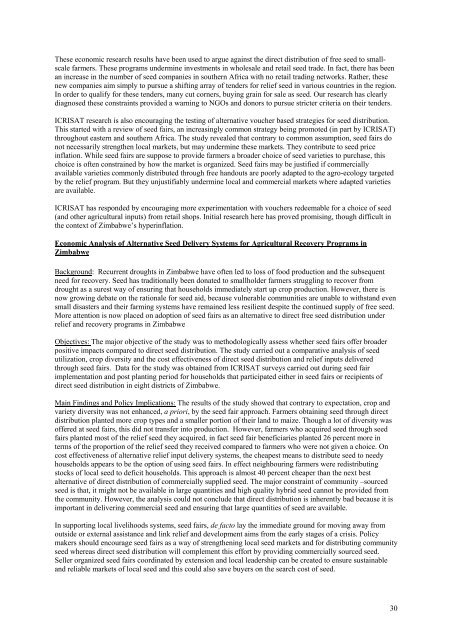ICRISAT Archival Report 2006 - The seedlings of success in the ...
ICRISAT Archival Report 2006 - The seedlings of success in the ...
ICRISAT Archival Report 2006 - The seedlings of success in the ...
You also want an ePaper? Increase the reach of your titles
YUMPU automatically turns print PDFs into web optimized ePapers that Google loves.
<strong>The</strong>se economic research results have been used to argue aga<strong>in</strong>st <strong>the</strong> direct distribution <strong>of</strong> free seed to smallscale<br />
farmers. <strong>The</strong>se programs underm<strong>in</strong>e <strong>in</strong>vestments <strong>in</strong> wholesale and retail seed trade. In fact, <strong>the</strong>re has been<br />
an <strong>in</strong>crease <strong>in</strong> <strong>the</strong> number <strong>of</strong> seed companies <strong>in</strong> sou<strong>the</strong>rn Africa with no retail trad<strong>in</strong>g networks. Ra<strong>the</strong>r, <strong>the</strong>se<br />
new companies aim simply to pursue a shift<strong>in</strong>g array <strong>of</strong> tenders for relief seed <strong>in</strong> various countries <strong>in</strong> <strong>the</strong> region.<br />
In order to qualify for <strong>the</strong>se tenders, many cut corners, buy<strong>in</strong>g gra<strong>in</strong> for sale as seed. Our research has clearly<br />
diagnosed <strong>the</strong>se constra<strong>in</strong>ts provided a warn<strong>in</strong>g to NGOs and donors to pursue stricter criteria on <strong>the</strong>ir tenders.<br />
<strong>ICRISAT</strong> research is also encourag<strong>in</strong>g <strong>the</strong> test<strong>in</strong>g <strong>of</strong> alternative voucher based strategies for seed distribution.<br />
This started with a review <strong>of</strong> seed fairs, an <strong>in</strong>creas<strong>in</strong>gly common strategy be<strong>in</strong>g promoted (<strong>in</strong> part by <strong>ICRISAT</strong>)<br />
throughout eastern and sou<strong>the</strong>rn Africa. <strong>The</strong> study revealed that contrary to common assumption, seed fairs do<br />
not necessarily streng<strong>the</strong>n local markets, but may underm<strong>in</strong>e <strong>the</strong>se markets. <strong>The</strong>y contribute to seed price<br />
<strong>in</strong>flation. While seed fairs are suppose to provide farmers a broader choice <strong>of</strong> seed varieties to purchase, this<br />
choice is <strong>of</strong>ten constra<strong>in</strong>ed by how <strong>the</strong> market is organized. Seed fairs may be justified if commercially<br />
available varieties commonly distributed through free handouts are poorly adapted to <strong>the</strong> agro-ecology targeted<br />
by <strong>the</strong> relief program. But <strong>the</strong>y unjustifiably underm<strong>in</strong>e local and commercial markets where adapted varieties<br />
are available.<br />
<strong>ICRISAT</strong> has responded by encourag<strong>in</strong>g more experimentation with vouchers redeemable for a choice <strong>of</strong> seed<br />
(and o<strong>the</strong>r agricultural <strong>in</strong>puts) from retail shops. Initial research here has proved promis<strong>in</strong>g, though difficult <strong>in</strong><br />
<strong>the</strong> context <strong>of</strong> Zimbabwe’s hyper<strong>in</strong>flation.<br />
Economic Analysis <strong>of</strong> Alternative Seed Delivery Systems for Agricultural Recovery Programs <strong>in</strong><br />
Zimbabwe<br />
Background: Recurrent droughts <strong>in</strong> Zimbabwe have <strong>of</strong>ten led to loss <strong>of</strong> food production and <strong>the</strong> subsequent<br />
need for recovery. Seed has traditionally been donated to smallholder farmers struggl<strong>in</strong>g to recover from<br />
drought as a surest way <strong>of</strong> ensur<strong>in</strong>g that households immediately start up crop production. However, <strong>the</strong>re is<br />
now grow<strong>in</strong>g debate on <strong>the</strong> rationale for seed aid, because vulnerable communities are unable to withstand even<br />
small disasters and <strong>the</strong>ir farm<strong>in</strong>g systems have rema<strong>in</strong>ed less resilient despite <strong>the</strong> cont<strong>in</strong>ued supply <strong>of</strong> free seed.<br />
More attention is now placed on adoption <strong>of</strong> seed fairs as an alternative to direct free seed distribution under<br />
relief and recovery programs <strong>in</strong> Zimbabwe<br />
Objectives: <strong>The</strong> major objective <strong>of</strong> <strong>the</strong> study was to methodologically assess whe<strong>the</strong>r seed fairs <strong>of</strong>fer broader<br />
positive impacts compared to direct seed distribution. <strong>The</strong> study carried out a comparative analysis <strong>of</strong> seed<br />
utilization, crop diversity and <strong>the</strong> cost effectiveness <strong>of</strong> direct seed distribution and relief <strong>in</strong>puts delivered<br />
through seed fairs. Data for <strong>the</strong> study was obta<strong>in</strong>ed from <strong>ICRISAT</strong> surveys carried out dur<strong>in</strong>g seed fair<br />
implementation and post plant<strong>in</strong>g period for households that participated ei<strong>the</strong>r <strong>in</strong> seed fairs or recipients <strong>of</strong><br />
direct seed distribution <strong>in</strong> eight districts <strong>of</strong> Zimbabwe.<br />
Ma<strong>in</strong> F<strong>in</strong>d<strong>in</strong>gs and Policy Implications: <strong>The</strong> results <strong>of</strong> <strong>the</strong> study showed that contrary to expectation, crop and<br />
variety diversity was not enhanced, a priori, by <strong>the</strong> seed fair approach. Farmers obta<strong>in</strong><strong>in</strong>g seed through direct<br />
distribution planted more crop types and a smaller portion <strong>of</strong> <strong>the</strong>ir land to maize. Though a lot <strong>of</strong> diversity was<br />
<strong>of</strong>fered at seed fairs, this did not transfer <strong>in</strong>to production. However, farmers who acquired seed through seed<br />
fairs planted most <strong>of</strong> <strong>the</strong> relief seed <strong>the</strong>y acquired, <strong>in</strong> fact seed fair beneficiaries planted 26 percent more <strong>in</strong><br />
terms <strong>of</strong> <strong>the</strong> proportion <strong>of</strong> <strong>the</strong> relief seed <strong>the</strong>y received compared to farmers who were not given a choice. On<br />
cost effectiveness <strong>of</strong> alternative relief <strong>in</strong>put delivery systems, <strong>the</strong> cheapest means to distribute seed to needy<br />
households appears to be <strong>the</strong> option <strong>of</strong> us<strong>in</strong>g seed fairs. In effect neighbour<strong>in</strong>g farmers were redistribut<strong>in</strong>g<br />
stocks <strong>of</strong> local seed to deficit households. This approach is almost 40 percent cheaper than <strong>the</strong> next best<br />
alternative <strong>of</strong> direct distribution <strong>of</strong> commercially supplied seed. <strong>The</strong> major constra<strong>in</strong>t <strong>of</strong> community –sourced<br />
seed is that, it might not be available <strong>in</strong> large quantities and high quality hybrid seed cannot be provided from<br />
<strong>the</strong> community. However, <strong>the</strong> analysis could not conclude that direct distribution is <strong>in</strong>herently bad because it is<br />
important <strong>in</strong> deliver<strong>in</strong>g commercial seed and ensur<strong>in</strong>g that large quantities <strong>of</strong> seed are available.<br />
In support<strong>in</strong>g local livelihoods systems, seed fairs, de facto lay <strong>the</strong> immediate ground for mov<strong>in</strong>g away from<br />
outside or external assistance and l<strong>in</strong>k relief and development aims from <strong>the</strong> early stages <strong>of</strong> a crisis. Policy<br />
makers should encourage seed fairs as a way <strong>of</strong> streng<strong>the</strong>n<strong>in</strong>g local seed markets and for distribut<strong>in</strong>g community<br />
seed whereas direct seed distribution will complement this effort by provid<strong>in</strong>g commercially sourced seed.<br />
Seller organized seed fairs coord<strong>in</strong>ated by extension and local leadership can be created to ensure susta<strong>in</strong>able<br />
and reliable markets <strong>of</strong> local seed and this could also save buyers on <strong>the</strong> search cost <strong>of</strong> seed.<br />
30

















